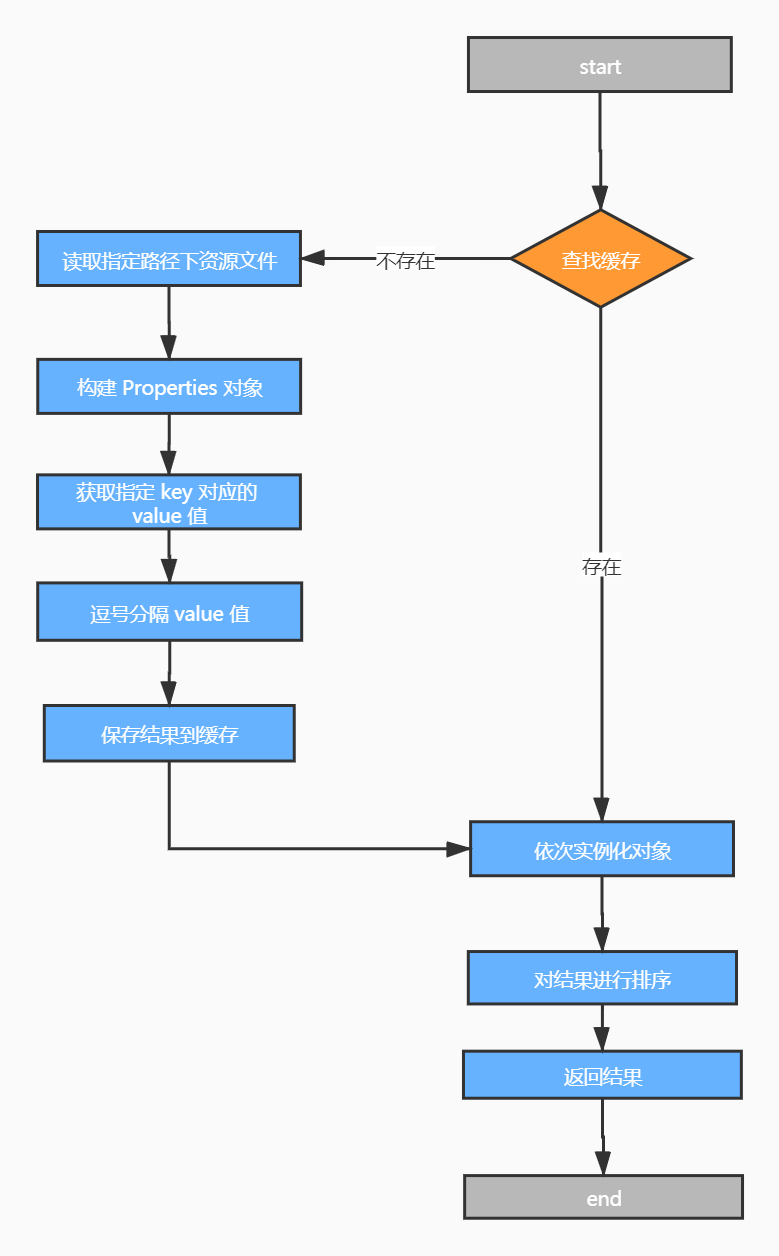一、SpringFactoriesLoader 介绍
1.1 SpringFactoriesLoader 简介
SpringFactoriesLoader 工厂加载机制是 Spring 内部提供的一个约定俗成的加载方式,与 java spi 类似,只需要在模块的 META-INF/spring.factories 文件中,以 Properties 类型(即 key-value 形式)配置,就可以将相应的实现类注入 Spirng 容器中。
Properties 类型格式:
key:是全限定名(抽象类|接口)
value:是实现,多个实现通过 **逗号** 进行分隔
1.2 SpringFactoriesLoader 常用方法
-
loadFactoryNames
读取 classpath上 所有的 jar 包中的所有 META-INF/spring.factories属 性文件,找出其中定义的匹配类型 factoryClass 的工厂类,然后并返回这些工厂类的名字列表,注意是包含包名的全限定名。 -
loadFactories
读取 classpath 上所有的jar包中的所有 META-INF/spring.factories 属性文件,找出其中定义的匹配类型 factoryClass 的工厂类,然后创建每个工厂类的对象/实例,并返回这些工厂类对象/实例的列表。
1.3 loadFactories 流程图

二、SpringFactoriesLoader 源码解析
2.1 loadFactoryNames 解析
public static List<String> loadFactoryNames(Class<?> factoryType, @Nullable ClassLoader classLoader) {
// 获取包含包名的工厂类名称
String factoryTypeName = factoryType.getName();
// 获取所有配置在 META-INF/spring.factories 文件的值
// 然后获取指定类的实现类名列表
return loadSpringFactories(classLoader).getOrDefault(factoryTypeName, Collections.emptyList());
}
// 默认的工厂配置路径地址,可以存放在多个 JAR 包下
public static final String FACTORIES_RESOURCE_LOCATION = "META-INF/spring.factories";
private static Map<String, List<String>> loadSpringFactories(@Nullable ClassLoader classLoader) {
// 判断是否有缓存结果,如果有直接返回
MultiValueMap<String, String> result = cache.get(classLoader);
if (result != null) {
return result;
}
try {
// 扫描 classpath 上所有 JAR 中的文件 META-INF/spring.factories
Enumeration<URL> urls = (classLoader != null ?
classLoader.getResources(FACTORIES_RESOURCE_LOCATION) :
ClassLoader.getSystemResources(FACTORIES_RESOURCE_LOCATION));
result = new LinkedMultiValueMap<>();
while (urls.hasMoreElements()) {
// 找到的每个 META-INF/spring.factories 文件都是一个 Properties 文件,将其内容加载到一个 Properties 对象然后处理其中的每个属性
URL url = urls.nextElement();
UrlResource resource = new UrlResource(url);
Properties properties = PropertiesLoaderUtils.loadProperties(resource);
for (Map.Entry<?, ?> entry : properties.entrySet()) {
// 获取工厂类名称(接口或者抽象类的全限定名)
String factoryTypeName = ((String) entry.getKey()).trim();
// 将逗号分割的属性值逐个取出,然后放到 结果result 中去
for (String factoryImplementationName : StringUtils.commaDelimitedListToStringArray((String) entry.getValue())) {
result.add(factoryTypeName, factoryImplementationName.trim());
}
}
}
// 将结果存放到缓存中
cache.put(classLoader, result);
return result;
}
catch (IOException ex) {
throw new IllegalArgumentException("Unable to load factories from location [" +
FACTORIES_RESOURCE_LOCATION + "]", ex);
}
}
default V getOrDefault(Object key, V defaultValue) {
V v;
return (((v = get(key)) != null) || containsKey(key))
? v
: defaultValue;
}
2.2 loadFactories 解析
public static <T> List<T> loadFactories(Class<T> factoryType, @Nullable ClassLoader classLoader) {
Assert.notNull(factoryType, "'factoryType' must not be null");
// 如果未指定类加载器,则使用默认的
ClassLoader classLoaderToUse = classLoader;
if (classLoaderToUse == null) {
classLoaderToUse = SpringFactoriesLoader.class.getClassLoader();
}
// 获取指定工厂名称列表
List<String> factoryImplementationNames = loadFactoryNames(factoryType, classLoaderToUse);
// 如果记录器Trace跟踪激活的话,将工厂名称列表输出
if (logger.isTraceEnabled()) {
logger.trace("Loaded [" + factoryType.getName() + "] names: " + factoryImplementationNames);
}
// 创建结果集
List<T> result = new ArrayList<>(factoryImplementationNames.size());
for (String factoryImplementationName : factoryImplementationNames) {
// 实例化工厂类,并添加到结果集中
result.add(instantiateFactory(factoryImplementationName, factoryType, classLoaderToUse));
}
// 对结果集列表进行排序
AnnotationAwareOrderComparator.sort(result);
return result;
}
private static <T> T instantiateFactory(String factoryImplementationName, Class<T> factoryType, ClassLoader classLoader) {
try {
Class<?> factoryImplementationClass = ClassUtils.forName(factoryImplementationName, classLoader);
if (!factoryType.isAssignableFrom(factoryImplementationClass)) {
throw new IllegalArgumentException(
"Class [" + factoryImplementationName + "] is not assignable to factory type [" + factoryType.getName() + "]");
}
return (T) ReflectionUtils.accessibleConstructor(factoryImplementationClass).newInstance();
}
catch (Throwable ex) {
throw new IllegalArgumentException(
"Unable to instantiate factory class [" + factoryImplementationName + "] for factory type [" + factoryType.getName() + "]",
ex);
}
}